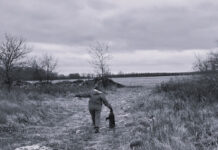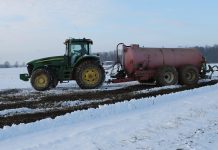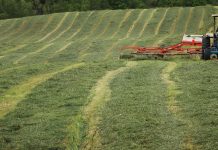We harvested the manure nutrient utilization and application research plots at the Myron Wehr Farm Nov. 4, and are pleased with the results.
Gary Graham, north district extension specialist in natural resources, and I have now completed two years of research on the problem of applying manure to cropland to get the most benefit from the manure nutrients without disturbing the no-till system.
We are still crunching numbers, but would like to report some of our preliminary findings while there is still time for you to make some decisions before year-end, in time for the 2004 cropping season.
What we did. The experiment was laid out in a randomized, replicated block design. The 10 treatments were repeated four times, plus we operated the Aerway tool over four additional strips without applying manure to see if this treatment had any effect on corn emergence and population.
Each strip was 30 feet wide (one 12-row planter width).
The 44 strips were each 350 feet long, covering a total of 10.6 acres. Each manure applicator covered a 10-foot width, so each treatment required three trips across each plot.
The same variety (Pioneer 36M28 was planted on all plots.
On Nov. 4, 2003, we harvested the center eight rows of each plot, weighed each harvested lot over a weigh wagon, tested moisture and calculated the yield of dry bushels per acre.
Incorporation is better. You already knew that you get more value from manure nitrogen when the manure is incorporated into the soil by injecting or tilling soon after application.
The problem is to find a way to incorporate manure without tillage so as to maintain the benefits of the no-till system.
This year we compared the Aerway system of distributing manure, the Balzer shallow injector system and Myron’s liquid nitrogen application system (applied with the planter).
We made fall (Dec. 18) and spring (April 16) applications of 11,800 gallons of liquid dairy manure (compliments of Pine Hill Jersey Farm, Scott Lindsay family) to provide 162 pounds per acre actual N.
We used both implements to make surface and incorporated applications.
To evaluate the effects of these treatments on the 2003 corn crop, we collected pre-sidedress nitrate and ammonia N, plant tissue composition, plant population, and yield data.
To evaluate the effects on the no-till system, we collected soil compaction and crop residue cover data.
The manure applications did not disturb the crop residue (double crop soybeans after wheat in 2002) enough to affect planting in 2003 with Myron’s no-till planter fitted with row cleaners.
Crop residue cover was checked before and after all treatments with the USDA-NRCS residue transect method. In no case did residue cover drop below the 33 percent minimum required for program compliance (lowest value was 49.1 percent residue cover for the Balzer spring incorporated plots).
Results. Corn yields averaged 160.0 bushels per acre over all treatments. Moisture content of all plots was standardized to 20.7 percent.
Spring and fall incorporated plots yielded the same (170.3 and 169.9 bushels per acre, respectively). Fall surface manure plots yielded 152.4, followed by spring surface plots at 146.0 bushels per acre.
By comparison, Myron’s liquid N at planting program (117 pounds per acre actual N) yielded 166.6 bushels per acre.
Yields from incorporated manure plots (both fall and spring) were significantly higher (170.1 bushels per acre vs. 149.2) than surface applied plots.
No significant soil compaction resulted from either manure distribution system.
Corn yield was highly correlated with plant tissue percent N. Corn yield was also correlated with pre-side-dress soil ammonia content and total inorganic soil N.
Implications. Despite slight population reductions with spring manure applications, no-till corn yields were optimum with no additional nitrogen applications where manure was incorporated either in spring or fall.
We had significantly better yields with manure incorporation, compared to surface applications.
We conclude that equipment is available for large-volume manure injection into the no-till cropping system, and that manure can provide all necessary nutrients for optimum no-till corn production.
These benefits, plus the additional benefits of manure injection (reduced runoff risk and odor reduction) make this technology worth considering.
More research. We already have laid out the research plots for the 2004 crop year and we hope to add another year of data. We may look at slightly reduced manure application rates and eliminating starter fertilizer altogether.
Special thanks to Myron Wehr, Scott Lindsay, Campbell Brothers (Balzer manure tank), Witmer Implement (Aerway implement and Husky tank) and Agland Cooperative (soil sampling) for generous support of this research! Thanks also to Wayne Bacon (Green Meadows Soil Service) (weigh Wagon) and Columbiana Soil and Water Conservation District (soil testing, plot marker flags and USDA/NRCS residue counting equipment).
(The author is an agricultural extension agent in Columbiana County. Questions or comments can be sent in care of Farm and Dairy, P.O. Box 38, Salem, OH 44460.)
Get 4 Weeks of Farm and Dairy Home Delivered












